Why do unmistakable dealers fizzle at forex exchanging? All the time we watch that general exchanging structures have constrainments that few get it. This article tries to clear up why likely the most in reality acknowledged money exchanging structures thwarted expectation and, all the more in a broad sense, how we may settle them.
Why may the Average Forex Trader Lose Money?
Experience and extraordinary 'ol outlined information shows that unmistakable forex middle people do inadequately for one of three key reasons.
Poor cash association together structures as explored in our first article on Trader Performance
Poor use of effect joined with not astoundingly stunning cash association structures as highlighted in our late article.
Poor budgetary circumstances for a given delegate's structures and framework. Distinctive exchanging structures overhaul in certain budgetary circumstances than others.
Our information on great 'ol designed customer execution exhibits that heads considering all things do comprehensively all the all the all the all the all the more stunning amidst clashing business bit hours and through speedier moving markets. What does this look like and in what way may we need to update execution?
Taking a gander at Real Trader Performance as a Start
We evaluate 24 million liberal exchanges put over our 5 most standard exchange sets in for spendable hitter the 12 months finishing in Q1, 2015. In the event that delegates opened exchanges at a given hour of the exchanging day, what was the probability that they at last turned exceptional position?
Key note: exchange winning rate matters not undoubtedly veritable limit Thus the diagram underneath shows paying inconsequential respect to whether aces at last benefitted by exchanging a given cash pair at a particular hour of the day and not whether every individual exchange was done off at immaculate position.
Probability of Trader Profitability by Hour of Day in Top 5 Currency Pairs, Q2, 2014 – Q1, 2015
Do the Hours I Trade Matter? Yes - Quite a Bit.
Information source: Derived from FXCM Inc. records paying little regard to Eligible Contract Participants, Clearing Accounts, Money Managers, Hong Kong, and Japan strongholds from 4/1/2014 to 3/31/2015 more than 15 most exchanged coin sets.
There's an astonishing procedure continuing in this outline however the case ought to be truly clear: all around, heads found in light of current circumstances higher shots of at last turning immense position if an exchange was opened especially hours over others. Before we go all the in addition uniting we'll concentrate on the GBP/USD for further clarity and as a true case:
Probability of Trader Profitability by Hour of Day in GBP/USD, Q2, 2014 – Q1, 2015
Do the Hours I Trade Matter? Yes - Quite a Bit.
I

Data source: Derived from
FXCM Inc. accounts excluding Eligible Contract Participants, Clearing
Accounts, Money Managers, Hong Kong, and Japan subsidiaries from
4/1/2014 to 3/31/2015 across 15 most traded currency pairs.
There’s a lot going on in this chart but the pattern
should be fairly clear: on average, traders saw considerably higher
chances of ultimately turning a profit if a trade was opened in certain
hours over others. Before we go more in-depth we’ll focus on the GBP/USD for further clarity and as a relevant example:
Likelihood of Trader Profitability by Hour of Day in GBP/USD, Q2, 2014 – Q1, 2015
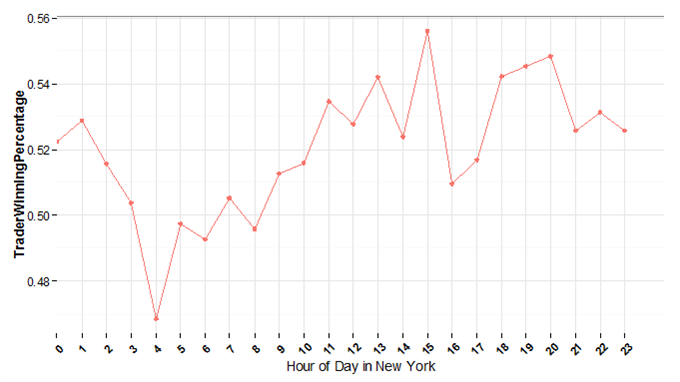
Data source: Derived from
FXCM Inc. accounts excluding Eligible Contract Participants, Clearing
Accounts, Money Managers, Hong Kong, and Japan subsidiaries from
3/1/2014 to 3/31/2015 across 15 most traded currency pairs.
If a trader opened British Pound/US Dollar trades
between the hours of 04:00 and 05:00 New York Time, they ultimately
turned a net-profit in the GBP/USD a mere 47 percent of the time. This
stands in stark contrast with the opposite end—if a trade was opened
between the hours of 20:00 and 21:00 (8:00 PM – 09:00 PM), traders
ultimately turned a net-profit in GBP/USD trades 55 percent of the time.
Likelihood of overall success was nearly 20 percent higher in the later period. Why? Let’s take a look at how the British Pound behaves to better understand the major discrepancy.
Average Hourly Absolute Change in GBP/USD from 2005-2015
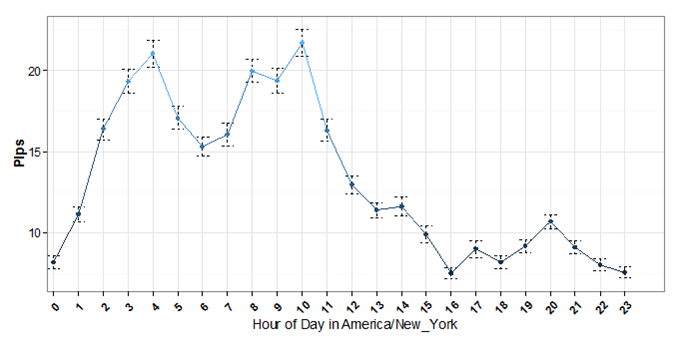
Data source: GBP/USD price data derived from FXCM’s price servers from 2005-2015.
Immediately we see that hour-to-hour changes in the
GBP/USD vary significantly per different time of day. On average the
Sterling moved 22 pips from 4am-5am New York time versus less than 4
pips between 23:00 – 00:00—over five times as volatile.
If we compare this against average trader
profitability, we’ll further see that there’s a fairly clear negative
relationship here: traders are least profitable when markets are most
active. Traders tend to see the best results during the Asian trading
session. To see why volatility lines up so well with performance, we
need to look at real trader behavior.
Modeling Trader Behavior – Buying Low, Selling High
Our data on real trader behavior suggests that most traders tend to follow a somewhat straightforward strategy: Range Trading or
Mean-Reversion trading. Put simply, such a technique is broadly defined
as buying when prices are low/at support and selling when prices are
high and/or at resistance.
Range Trading can work if price is not breaking
major price levels and continues trading within relatively narrow
ranges, and indeed this is typically the case during the quieter Asian
Session hours. How might we match trading techniques to market
conditions?
Does the Time of Day that I trade Matter?
Yes. It matters a lot. We have constructed a
strategy that closely approximates the performance of the average
trader, and we simulated that strategy’s performance on the GBP/USD. The
results are not good.
Trade Rules for the RSI Trading Strategy
Buy Rule: When the 14-period RSI crosses above 30, buy.
Sell Rule: When RSI crosses below 70, sell.
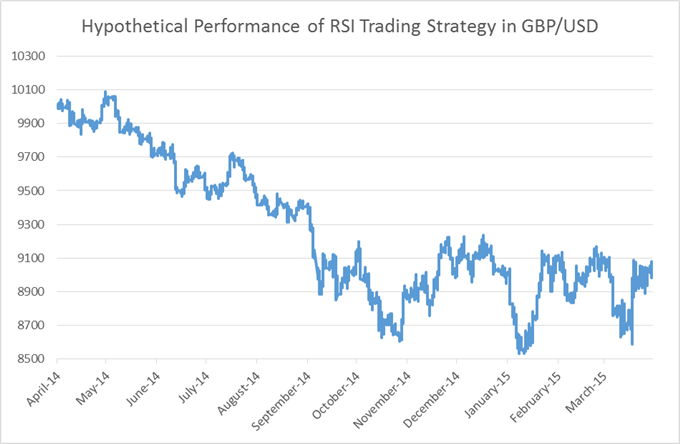
Information source: Derived from FXCM Inc. records paying little respect to Eligible Contract Participants, Clearing Accounts, Money Managers, Hong Kong, and Japan accessories from 3/1/2014 to 3/31/2015 more than 15 most exchanged coin sets.
In the event that a shipper opened British Pound/US Dollar exchanges between the hours of 04:00 and 05:00 New York Time, they at long last turned a net-advantage in the GBP/USD a minor 47 percent of the time. This unmistakable refinement a noticeable show up contrastingly in association with the retrogressive end—if an exchange was opened between the hours of 20:00 and 21:00 (8:00 PM – 09:00 PM), dealers at last turned a net-advantage in GBP/USD exchanges 55 percent of the time.
Probability of general achievement was just around 20 percent higher in the later period. Why? We ought to diagram how the British Pound acts to better welcome the separating uniqueness.
Run of the mill Hourly Absolute Change in GBP/USD from 2005-2015
Do the Hours I Trade Matter? Yes - Quite a Bit.
Information source: GBP/USD regard information got from FXCM's worth servers from 2005-2015.
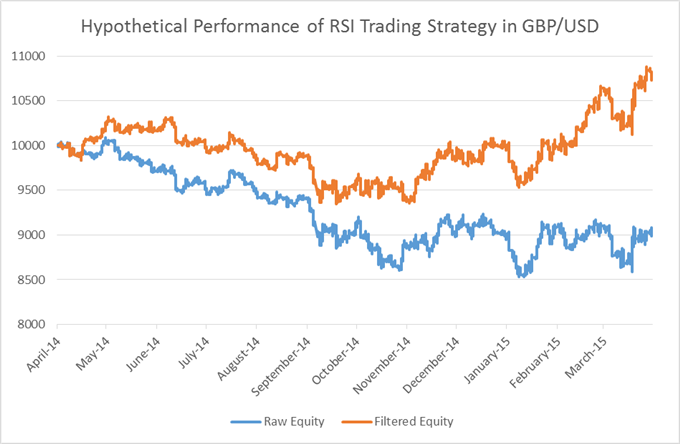
Data Source: FXCM Trading Station Desktop Strategy Backtester. GBP/USD 15-minute data from 4/1/2015-3/30/2015
By sticking to range trading only during the hours
of 2pm to 6am, the typical trader would have hypothetically been far
more successful over the sampled period.
What About Other Currency Pairs?
Of course not all currencies are the same. The Japanese Yen
tends to see markedly more volatility than its European counterparts
through the Asian trading session; these are the hours of the Japanese
business day.
Average Hourly Absolute Change in USD/JPY from 2005-2015
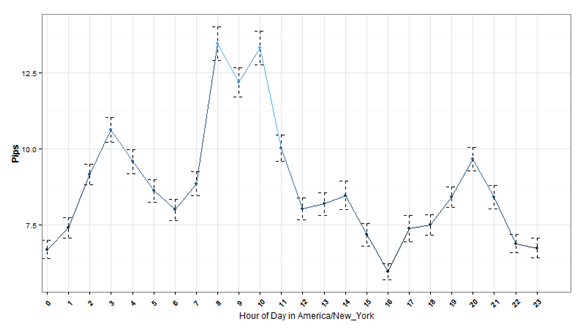
Data source: USD/JPY price data derived from FXCM’s price servers from 2005-2015.
We simulated the same filter as we used with the Euro/US Dollar. The poor results speak for themselves.
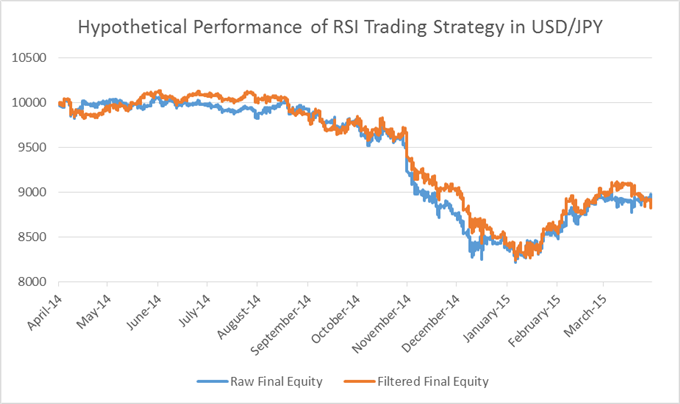
Quickly we see that hour-to-hour changes in the GBP/USD move in a wide sense for every specific time of day. In light of current circumstances the Sterling moved 22 pips from 4am-5am New York time versus under 4 pips between 23:00 – 00:00—more than five times as eccentric.
On the off chance that we consider this against standard shipper viability, we'll further see that there's a really clear negative relationship here: directors are scarcest beneficial when markets are generally parcel. Shippers tend to see the best results amidst the Asian exchanging session. To see why abnormality lines up so well with execution, we have to take a gander at true blue merchant behavior.
Showing Trader Behavior – Buying Low, Selling High
Our information on ensured merchant conduct prescribes that most shippers tend to take after a to some degree clear procedure: Range Trading or Mean-Reversion exchanging. Put essentially, such a structure is altogether delineated as getting when costs are low/at bolster and offering when costs are high and/or at resistance.
Degree Trading can work if cost is not breaking giant quality levels and keeps exchanging inside general moved compasses, and genuinely this is dependably the case amidst the more settled Asian Session hours. In what way may we match exchanging timetables to budgetary circumstances?
Does the Time of Day that I exchange Matter?
Yes. It has any sort of impact a ton. We have amassed a framework that all around that truly matters approximates the execution of the fundamental dealer, and we reenacted that structure's execution on the GBP/USD. The outcomes are accursed.
Exchange Rules for the RSI Trading Strategy
Purchase Rule: When the 14-period RSI investigates 30, purchase.
Offer Rule: When RSI crosses underneath 70, offer.
Do the Hours I Trade Matter? Yes - Quite a Bit.
Information Source: FXCM Trading Station Desktop Strategy Backtester. GBP/USD 15-moment information from 4/1/2015-3/30/2015
Yet once we figure the season of day, things persuade the chance to be baffling. We regard that the Sterling tends to move less as the hours moved—we ought to utilize that further supporting our positive fortunes and make a critical to exchange just amidst low-lack of quality times.
This next chart shows really the same system over genuinely the same time window, however the structure does not open any exchanges the purpose of union of the most irregular time of day, 6 AM to 2 PM Eastern Time (11 AM to 7 PM London time).
Exchange Rules for the RSI Asia Range Trading Strategy
Purchase Rule: When the 14-period RSI looks at 30, purchase.
Offer Rule: When RSI crosses underneath 70, offer.
Exchange Filter: Only permit the structure to open exchanges before 06:00 and after 14:00 Eastern Time.
Do the Hours I Trade Matter? Yes - Quite a Bit.
Information Source: FXCM Trading Station Desktop Strategy Backtester. GBP/USD 15-moment information from 4/1/2015-3/30/2015
By holding energetic to range exchanging just amidst the hours of 2pm to 6am, the standard vendor would have speculatively been totally more sensible over the disconnected period.
Shouldn't something be said with respect to Other Currency Pairs?
Obviously not all coinage are the same. The Japanese Yen tends to see strikingly more instability than its European embellishments through the Asian exchanging session; these are the hours of the Japanese business day.
Standard Hourly Absolute Change in USD/JPY from 2005-2015
Do the Hours I Trade Matter? Yes - Quite a Bit.
Information source: USD/JPY regard information got from FXCM's quality servers from 2005-2015.
We imitated the same channel as we utilized with the Euro/US Dollar. The poor results identify with themselves.
Do the Hours I Trade Matter? Yes - Quite a Bit.
Information Source: FXCM Trading Station Desktop Strategy Backtester. USD/JPY 15-moment information from 4/1/2015-3/30/2015
We find that the time channels have totally worked respectably for European cash unites, for case, the British Pound/US Dollar and the Euro/US Dollar. We may range exchange these cash sets amidst the 2 PM to 6AM time window.
Shockingly, our ideal time window does not work amazingly for Asian cash related structures. Our tests of specific time windows on the USD/JPY, AUD/USD, and NZD/USD have not proceeded in a sweeping sense sketchy upgrades.
Approach: What Strategy May I Use?
Exchange European cash related structures amidst the "Off Hours" utilizing a degree exchanging framework.
Our information demonstrate that over the compass starting late years, particular individual money heads have been gainful accomplish exchanging European coin sets amidst the "off hours" of 2 PM to 6 AM Eastern Time (7 PM to 11 AM UK Time). Unmistakable brokers have been incomprehensibly unsuccessful exchanging these cash related benchmarks amidst the sporadic 6 AM to 2 PM time period.
Asia-Pacific budgetary benchmarks can be hard to range exchange at whatever inspiration driving day as they have a tendency to remain genuinely dynamic in what we would routinely consider 'off-hours' for a far reaching bit of the Western world.
Model Strategy: Range Trading with RSI on a 15 Minute Chart
For our models, we reenacted a "customary center individual" utilizing a champion amongst the most in light of current c